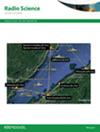Design and optimization of a low-cost 5-m radio telescope at princess Nourah university (PNU), Saudi Arabia
IF 1.5
4区 地球科学
Q3 ASTRONOMY & ASTROPHYSICS
引用次数: 0
Abstract
This paper presents the design and optimization of a low-cost, 5-m radio telescope developed at Princess Nourah University (PNU), focusing on the 1,420 MHz spectral line of neutral hydrogen (HI) for studying the structure and dynamics of the Milky Way galaxy. The design process integrates key principles of radio telescope engineering, including the optimization of the parabolic dish's geometry, reflectivity, and feed horn design and positioning. Key design outcomes include achieving a sensitivity of 19.63 m2 and an angular resolution of 2.94° providing our telescope with the ability to detect faint cosmic signals. Additionally, the focal length was optimized at 1.75 m with conical feed horn of circular aperture radius of 81.7 mm providing a directivity of 6.47 dB and an aperture efficiency of 51% achieving semi-optimal illumination for the designed reflector to minimize the signal loss. The resulting telescope gain of approximately 35 dB supports clear signal capture within the required frequency range. These performance metrics were verified through both simulations and experimental observations, confirming the high performance of our proposed radio telescope design. The advantages of this design include its affordability, replicability, and suitability for educational and research purposes, making it an accessible tool for radio astronomy studies in developing regions. The proposed radio telescope offers a cost-effective solution for institutions seeking to engage in astronomical research and develop hands-on learning experiences in antenna design and signal processing.沙特阿拉伯诺拉公主大学(PNU)低成本5米射电望远镜的设计与优化
本文介绍了诺拉公主大学(PNU)研制的低成本5米射电望远镜的设计与优化,该望远镜聚焦于中性氢(HI)的1,420 MHz谱线,用于研究银河系的结构和动力学。设计过程集成了射电望远镜工程的关键原则,包括抛物面天线几何形状、反射率和馈电喇叭设计和定位的优化。关键的设计成果包括实现19.63 m2的灵敏度和2.94°的角分辨率,使我们的望远镜能够探测到微弱的宇宙信号。此外,将焦距优化为1.75 m,圆孔径半径为81.7 mm的锥形进给角提供了6.47 dB的指向性和51%的孔径效率,使设计的反射器达到了半最佳照明,最大限度地减少了信号损耗。由此产生的望远镜增益约为35 dB,支持在所要求的频率范围内清晰的信号捕获。通过模拟和实验观测验证了这些性能指标,证实了我们提出的射电望远镜设计的高性能。这种设计的优点包括其可负担性、可复制性以及适合于教育和研究目的,使其成为发展中地区射电天文学研究的可访问工具。拟议中的射电望远镜为寻求从事天文研究的机构提供了一种经济有效的解决方案,并为天线设计和信号处理提供了实践学习经验。
本文章由计算机程序翻译,如有差异,请以英文原文为准。
求助全文
约1分钟内获得全文
求助全文
来源期刊

Radio Science
工程技术-地球化学与地球物理
CiteScore
3.30
自引率
12.50%
发文量
112
审稿时长
1 months
期刊介绍:
Radio Science (RDS) publishes original scientific contributions on radio-frequency electromagnetic-propagation and its applications. Contributions covering measurement, modelling, prediction and forecasting techniques pertinent to fields and waves - including antennas, signals and systems, the terrestrial and space environment and radio propagation problems in radio astronomy - are welcome. Contributions may address propagation through, interaction with, and remote sensing of structures, geophysical media, plasmas, and materials, as well as the application of radio frequency electromagnetic techniques to remote sensing of the Earth and other bodies in the solar system.
 求助内容:
求助内容: 应助结果提醒方式:
应助结果提醒方式:


